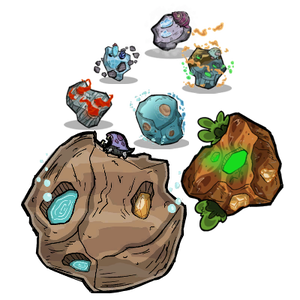Planetoid (Spaced Out)
Reason: "Article is redundant and incomplete. Planetoid Clusters and its redirects contain all necessary info from this page"
In Spaced Out! DLC, a planetoid is a space destination that can be landed on to build an outpost or colony, they differ from normal space destinations, as they usually contain geysers, and gravitas ruins along with life sustaining materials, they also contain rare materials. Planetoids spawn at a minimum of two tiles from the starting planetoid in the star map, with the nearest planetoid being connected through a teleporter. Planetoids serve as the primary mechanic for the spaced out dlc, as different planetoids allow for multiple colonies running simultaneously, they also come with gravitas structures, with the most important being the temporal tear opener, and the Experiment 52-B room, located on the cold and marshy planetoids respectively, however every planetoid contains a gravitas ruins containing an artifact, with the closest also containing a starting base ruins with a cryo tank and rations box.
Types of Planetoids
Water Planetoid
The Water Planetoid is a space destination containing large amounts of Water, high yield water geysers, and Graphite, an important component in the production of Fullerene. The planetoid is almost entirely submerged, with isolated pockets of Sandstone containing various resources, such as water geysers, oxylite, or useful minerals. The lower portion of the planetoid contains deposits of natural Lime and Graphite, which can be refined into Fullerene at the Molecular Forge, as well as possessing the highest Radiation blocking among raw minerals.
The massive amount of water is the primary challenge on this planetoid. High Liquid pressure combined with the prevalent Sandstone's poor resistance to pressure damage makes underwater construction difficult and can frequently result in natural tiles being destroyed. Pressure-resistant materials such as Granite or Steel can make the construction of a base in the watery depths significantly more feasible.
Superconductive Planetoid
The Superconductive Planetoid is the main source of Niobium, required for Thermium. Aside from a platform of Obsidian that can be used to land on, the surface is covered in Magma. While breaching the sea of magma is a considerable challenge, below it is the Niobium Biome, containing veins of Niobium and a single Niobium Volcano, surrounded by Obsidian. This planetoid's high temperatures pose a serious risk to the unprepared, and heat-resistant building materials will be needed to breach the magma sea and access the valuable Niobium that lies beneath.

